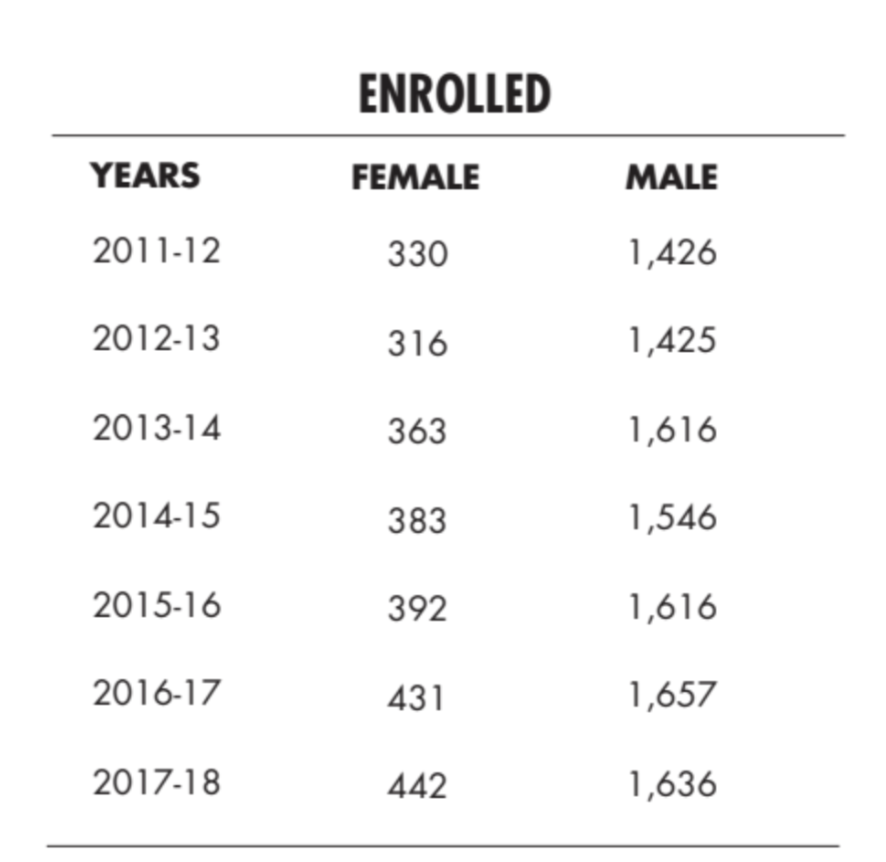Michelle Marchante/News Director
While the University has seen a steady 43 percent increase in women applicants for the College of Engineering and Computing, the same can’t be said for the number of enrolled women, with the college only seeing a 23 percent increase since 2011.
National numbers aren’t much better, according to the 2017 update of “Women In STEM,” a report released by the U.S. Department of Commerce, Economics and Statistics Administration Office of the Chief Economist.

These are the amount of women and men accepted into FIU’s College of Engineering and Computing in the past few years. Data graphic by Nicole Stone/PantherNOW
Besides computer science, mathematics, engineering, life and physical sciences, three management occupations with direct STEM ties were considered for the report. STEM educators and social scientists were also excluded.
While women are obtaining undergraduate degrees more than men, they only make up about 30 percent of all STEM degrees, the report states.
However, one student expects these numbers will change in the next 10 to 15 years because of the educational push happening to get girls more interested in the fields of science, technology, engineering and math.
Lissett Muñoz, a senior, is a teaching assistant for Girls Who Code and also works with Code/Art, a non-profit that teaches coding to young girls.
Working with these organizations, she said, has given her the opportunity to see the enthusiasm, the interest and the ability girls have for the field.

These are the amount of students actually enrolled in FIU’s College of Engineering and Computing. Data graphic by Guethshina Altena/PantherNOW.
Muñoz herself is also majoring in computer science, but her initial entrance into the field was unusual, she said.
When she was applying to the university, she was looking for the “undecided” button but didn’t see it. So, she decided to put computer science upon her father’s recommendation that it would give her multiple job options.
It was the right decision for her, Muñoz said, and she now has a summer programming internship lined up with Home Depot.
But, she can’t help wonder if her ethnicity and sex had a role in her acquiring the internship.
While women made up 47 percent of all U.S. jobs in 2015, only 24 percent of women worked in the STEM field, states the 2017 report.
Muñoz sees this gap even in her own classes.
“I have literally been the only woman in a class before, which was funny,” Muñoz said. “I wasn’t offended or upset by it, it was just funny.”
Claudia Ruiz, a sophomore majoring in computer engineering who will soon start working in the Student Affairs Technology Center, has had similar experiences. Her engineering orientation group only had five girls and then two of those girls dropped, she said.
Muñoz and Ruiz also agree that three to five girls is the average you can expect from a minimum class size of 25.
Like Muñoz, Ruiz believes society will soon see an increase of women studying and working in STEM.
“Especially with this time and age, women are learning that yes, you can be an engineer,” said Ruiz. “And no, engineering isn’t getting down in the dirt and constructing something if you don’t want it to be.”
Nadia Mazinani, a sophomore biology major in the pre-med track, comes from a family that works in the health industry and knew she would follow in their footsteps. But, it wasn’t until high school that she was diagnosed with Stage II cancer that she decided to become a doctor.
“The doctors I know really helped save my life so to go into that profession and be able to do the same for future kids is just a way to give back and I guess now my reason to becoming a doctor is more important or meaningful,” said Mazinani, who is currently in remission.
The STEM gender inequality, however, is only noticeable in certain degrees, according to Nadia Mazinani, a sophomore biology major in the pre-med track.
The ratio between men and women is about equal in her biology and chemistry classes, Mazinani said, but physics is another story.
There were very few women in her class, she said, and all her teaching assistants were men.
However, while this gender gap may exist, all three students said it doesn’t affect their interaction with classmates.
“They [male classmates] treat me like an equal which is something I think a lot of people are surprised at that they don’t look down on me,” Muñoz said.
Even though the guys don’t care if you’re a girl, Ruiz said she’s noticed that she and other girls naturally gravitate toward each other during classes.
But the potential lack of female friendships shouldn’t stop girls from entering STEM, Muñoz said.
“Just do it, just pursue it,” Muñoz said. “There’s nothing that should stop you from pursuing something that you’re interested in and if you live with that mentality your whole life you’re never gonna do anything that you like.”
And fear, Ruiz said, should never stop anyone from trying.
“Don’t be afraid to go out and do it because you might be good at it,” Ruiz said. “If you like math, do math. It doesn’t matter if it’s mostly boys or girls in your classes. If it’s something you want to do don’t let anyone deter you from doing it, not your parents not your teachers —nobody— don’t let anyone ever tell you that’s not something that a girl would do or that’s not girl-like just try.”
Feature Image retrieved from Flickr.






Be the first to comment on "Data shows slight increase of women in College of Engineering and Computing"